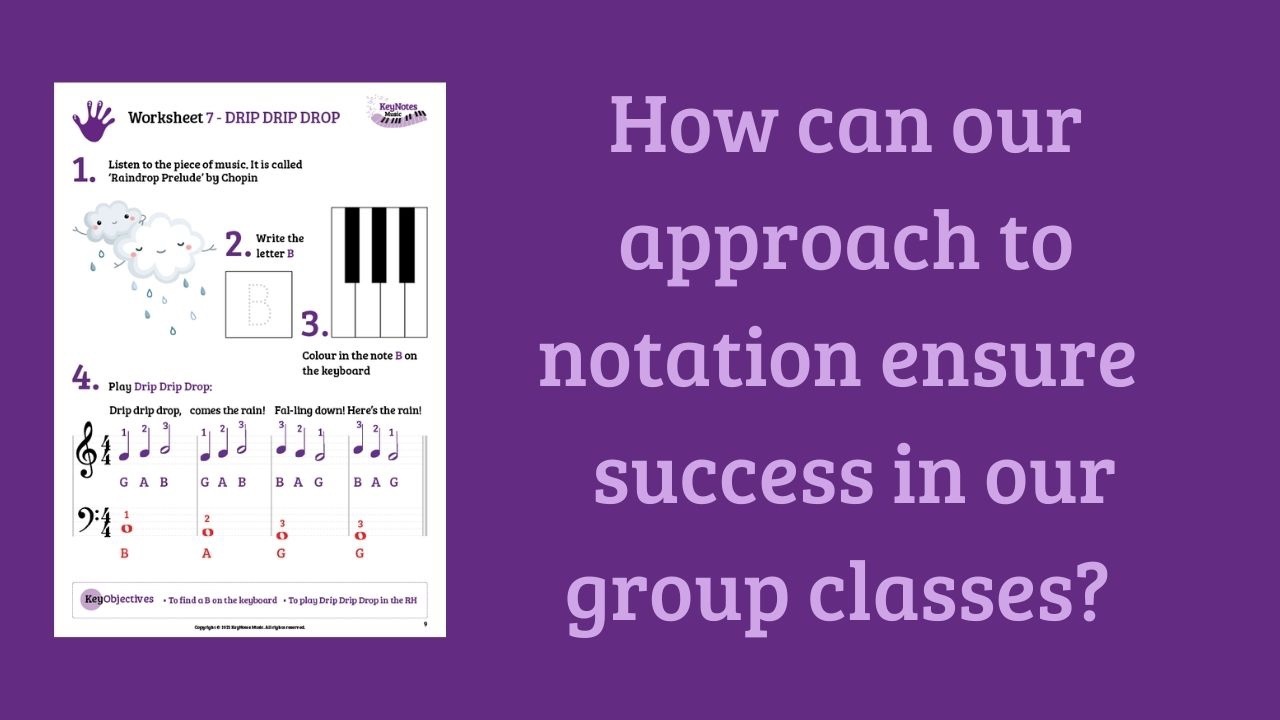Reading Music and our Approach in Groups
Feb 11, 2021
IN my last blog post, I talked about the importance of nurturing independent learning skills in our groups and what that might look like.
In this post I am going to talk about how crucial it is that we set up the learning to ensure that our learners can be independent. The very success of our groups rely on it. If we send six children off to keyboards and they have no idea what to do or how to play the piece for the lesson, we would have a very difficult job on our hands.
I am certain that this would definitely happen with many beginner method books. You know, the ones where EVERYTHING is given to children at once - treble clef, bass clef, keyboard geography, rhythm and finger numbers. I understand why this is done, but in KeyNotes we take a different approach, for a number of reasons. Firstly because we want our students to feel they are playing something meaningful straight away, to really enjoy the sound of what they are playing; to learn to play alongside learning to read, makes for slow playing progress. Secondly because there would be too many obstacles in the way of them being able to achieve, succeed and progress if we are expecting them to process too many things at once.
So we break the learning down.
I am going to illustrate this through our approach to notation. Our aim is to introduce all the elements of reading in steps, giving some information, but not all of it, whilst also not teaching anything that they will have to unlearn at a later date (no gimmicks!).
Here is an example of our pre-reader stave that we use both for our Little KeyNotes students (age 4-5) and our Storytellers beginners (ages 6+):

The design of these pages is carefully worked out to ensure accessibility for children - there are many routes they could take to understand and interpret the notation. Some will prefer to read and sing the finger numbers, knowing that they need to start on a certain note, others will read the letter names, which will directly instruct what they play, and others will sing the lyrics and almost learn the song by rote (although we do encourage them to look at the page for confirmation that they are playing what is written!). But ALL (or most at least!) will have a way of interpreting the music and being able to play it on their piano or keyboard without needing us there at every moment to interpret, correct or guide. This is a very powerful gift we are giving to our children.
Our job is then to check their understanding and move them onto challenges where appropriate (in order to differentiate for each individual).
By having very faint and dotted stave lines, we are giving some information about what a stave looks like, space notes and line notes, and pitch direction. But we are not relying on their knowledge of those things to be able to access the music.
As listed on the image, there are many ways in which a student could be prompted and supported by what is on the page; enough for them to interpret and access the music without it looking like a foreign language and being undecipherable without a lot of prior knowledge and help.
This gives both our little ones (ages 4 to 5) and our older beginners, some ownership and complete understanding of how to read, how what is on the page can be applied to the piano and how the two are related.
Our next level of notation is for our Storytellers Readers. These are also age 6+ students that are secure on their keyboard geography, finger numbers, and basic rhythms, and can now turn their attention to the treble clef (which is in line with our step-by-step approach):

As you can see, the treble clef line now looks like a 'normal' stave, with no letter names given and fingering only given as appropriate. Since all of our learning, our games and our application of knowledge to our playing, is based around the treble staff, we have given the left hand part as a pre-reader stave, with greyed-out lines and the letter names written in.
The final step in our students' journey to mastering note reading is a more 'usual' looking grand stave - with a focus on treble clef first of all (particularly where students didn't do the Storytellers Readers, which some of them don't), and then finally the bass clef.

There are many paths to reading proficiency (which is probably one of the most difficult parts of piano learning), but in groups we need to give our students every chance to manage and be secure in each step so that they can practice independently and so that reading does not halt or slow their playing progress, and their love of the piano.
Did you know that you can use the KeyNotes program in your studios? If you would like to teach outstanding group classes, click here to find out more about how you can join us!
Want to learn more about the
KeyNotes Music program?
Download our teacher information brochure to discover what our license includes, which programs we offer and what our approaches to learning are:
We will send you emails from KeyNotes Music, unsubscribe at any time.

